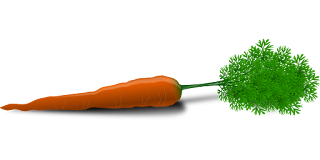Fat Soluble Vitamins
We will understand what exactly.
Vitamin A, D, E, K are all fat soluble ones. Vitamins are organic compounds that are needed in small quantities to sustain life.
Most vitamins need comes from food as the body cannot manufacture them.
There are 13 known vitamins, out of which 4 are fat soluble, Vitamin A, D, E, K. Water-soluble is Vitamin C and all the B'S.
Fat-soluble vitamins are stored in the fatty tissues of the body and the liver and they can stay in the body for days, and sometimes even months.
Let's start with Vitamin A. Pre-formed vitamin A is found in animal products.
Pro-vitamin is found in fruits and vegetables.
Beta-carotene is one common example. It's called a pro-vitamin because it's a precursor and the body converts it into its usable form.
Vitamin A
Vitamin A plays many roles in our body including regulation of the immune system, a role in bone & tooth development, reproduction, vital for hair growth, and essential for maintaining the light sensing cells in the eye.
It is abundantly available in animal products like milk and liver and in some fish.
Plant-based foods like carrots, sweet potatoes and green leafy vegetables have this vitamin too.
Vitamin A deficiency is rare, but it may result in diseases known as xerophthalmia.
Night blindness, very dry skin are other signs of Vitamin A deficiency.
Vitamin D
Vitamin D is a fat-soluble vitamin, which means it can be stored in the body for a long time, just like vitamins A, E and K. When exposed to sunlight, your skin produces Vitamin D and sends it to your liver.
From there, your liver changes it to a substance called 25(OH)D.
It then gets converted to 1,25(OH)2D, mostly in the kidneys.
This is the active steroid form of Vitamin D.
The active form of Vitamin D travels through the body, affecting almost every cell.
Functions of Vitamin D One of the most vital functions of Vitamin D is regulating the absorption of calcium and phosphorous, which is important for normal growth and development of bones and teeth.
There is also strong evidence for a protective effect of Vitamin D, not only against several types of cancer but also against multiple sclerosis and type 1 diabetes mellitus.
Here are two ways to get more Vitamin D:
Sun The best way to get adequate Vitamin D is through moderate exposure to the sun during appropriate times.
If possible, expose at least your arms, legs, and back for 15 to 20 minutes two or three times a week.
You can put sunscreen on after twenty minutes to prevent excessive sun exposure, which may cause premature aging and increase cancer risk.
If you work a night shift or live in Canada or Iceland where there is no sun most of the year, taking a supplement can help ensure that you get enough Vitamin D.
Remember that Vitamin D is fat soluble, so it is possible to overdose, as it can accumulate over time and potentially become toxic.
This is extremely rare, however. A note about Vitamin D and food:
It’s close to impossible to get enough Vitamin D from food.
For example, 100 grams of salmon has about 500 IU, and a whole egg has about 50 IU.
To be in the optimal range (40ng/ml—65ng/ml) you will need at least a few thousands IU daily.
Make sure to check out the article I have written in the extra reading section.
Vitamin E
Vitamin E is a group of related compounds divided into tocopherols and tocotrienols.
Alphatocopherol is the most common type.
It makes up for 90% of the Vitamin E in the blood..
Vitamin E's main role is to act as an antioxidant, preventing oxidative stress and protecting fatty acids in your cell membranes from free radicals.
These antioxidant properties are enhanced by other nutrients, such as vitamin C, vitamin B3 and selenium.
In high amounts, vitamin E also acts as a blood thinner, reducing the blood's ability to clot. Best sources of vitamin e are vegetable oils, nuts and seeds Vitamin E deficiency is uncommon and is never detected in people who are otherwise healthy.
It happens most often in diseases that impair the absorption of fat or vitamin E from food, such as cystic fibrosis and liver disease.
Symptoms of vitamin E deficiency include muscle weakness, walking difficulties, tremors, vision problems, poor immune function and numbness.
Vitamin K
Vitamin K is a family of compounds. The main dietary forms are vitamin K1, found in plant foods, and vitamin K2, found in animal-derived foods and fermented soy products.
Vitamin K plays an essential role in blood clotting. In fact, the "K" stands for "koagulation," the Danish word for coagulation, which means clotting.
But vitamin K has other functions as well, including supporting bone health and helping prevent the calcification of blood vessels, potentially reducing the risk of heart disease The best dietary sources of vitamin K1 (phylloquinone) are leafy green vegetables like spinach, kale, whereas vitamin K2 (menaquinone) is mainly found in animal-sourced foods and fermented soy products.
Without vitamin K, your blood wouldn't clot and even a small wound could cause unstoppable bleeding. Fortunately, vitamin K deficiency is rare, since the body only needs small amounts to maintain blood clotting.
Low levels of vitamin K have also been linked with reduced bone density and increased risk of fractures in women So this is the end of Fat SOLUBLE Vitamins and now let's look at the 9 water-soluble vitamins.
Unlike, fat-soluble vitamins, water-soluble are generally not stored in the body.
Therefore, you should strive to consume them from your diet regularly.





Comments
Post a Comment